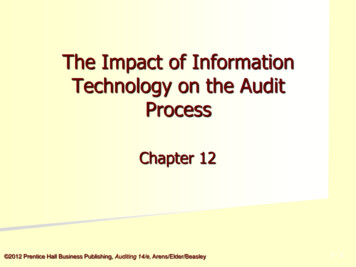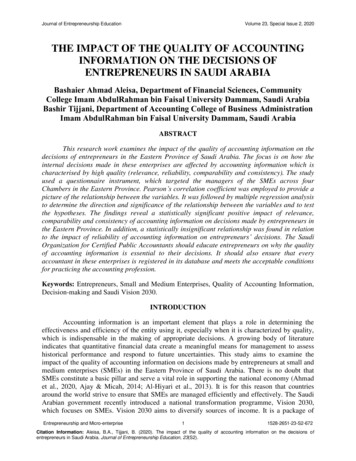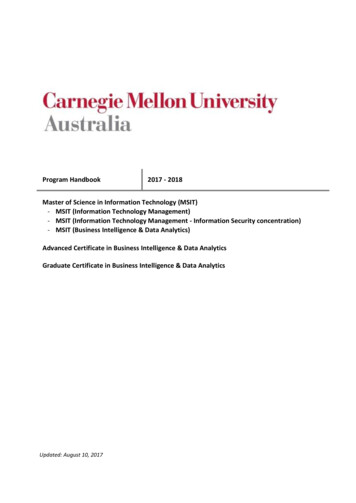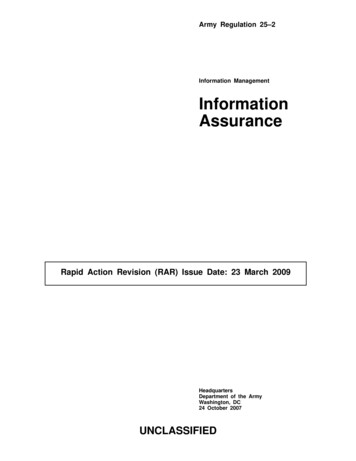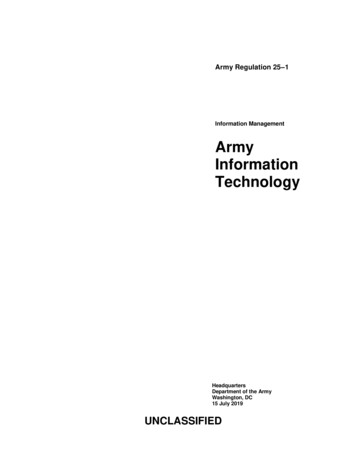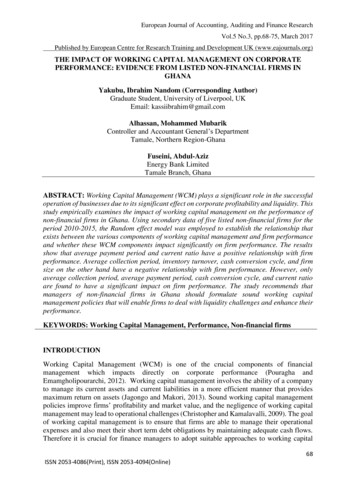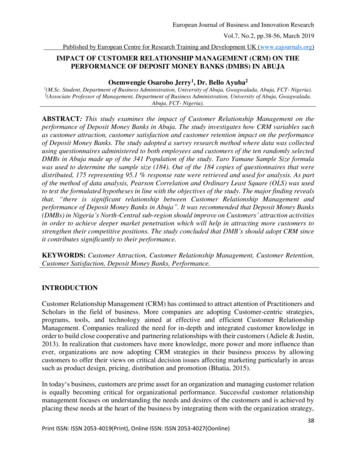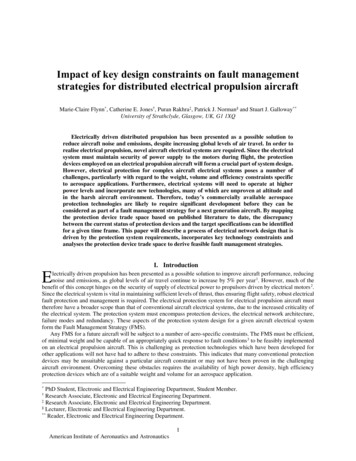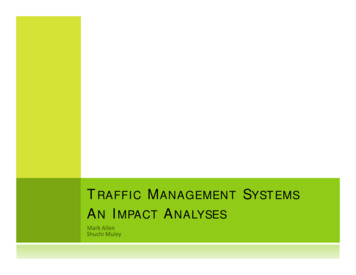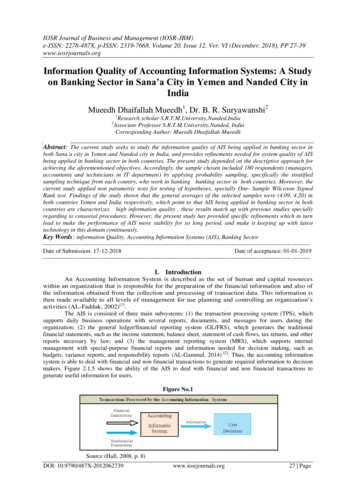
Transcription
International Journal of Business and Social ScienceVol. 4 No. 17 [Special Issue – December 2013]The Impact of Management Information Systems on the Performance ofGovernmental Organizations- Study at Jordanian Ministry of PlanningDr. Shehadeh M.A.AL-GharaibehAssistant prof. Business Administration DepartmentEconomic and Business CollageJadara UniversityIrbidDr. Nazem M.M. MalkawiAssociate ProfessorChair of Management Information Systems DepartmentBusiness CollageJadara UniversityIrbidAbstractThis study aimed to identify the impact of management information systems (MIS) on the performance ofgovernmental organizations, Jordanian Ministry of Planning – case study, a sample consisted of 77 employees inthe ministry, the study found: there is no impact of hardware and software equipment on the performance ofgovernmental organizations, there is a significant impact of networks, individuals and procedures, andmanagement information system as a whole on the performance of governmental organizations. At the endresearchers recommended the ministry updating MIS continuously, engaging employees in building systems, andtrain then on the system.Key Words: management information system, performance management, governmental organization.IntroductionThe scientific revaluation in the communication and information make a comprehensive change in the life andbusiness, which affect the ways that the governments provided its services to populations. Which also affect thefuture of the nations?The new technology helps to reduce managerial cost and human cost and make the work more accurate and faster;which make the governments go to the electronic governments. Form this point the role of (MIS) managementinformation system is to manage the data, organizing, retrieving of the information which help the organization toprovide services faster, and market more accurate and easier, which affect also the level of performance.From this point the importance of this study the effect of MIS on the performance of governmental organizationscomes.1. Importance of studyThe importance of the study comes from the importance of management information systems on the performanceof the governmental organizations, and its role in providing the appropriate data and information both internallyand externally in order to support management function, giving advanced solutions for managers, helpingadministrators to take correct decision in a large margin, improve the administrative level in governmentalorganizations.2. Problem of the studyWe can summarize the problem of the study in the main question: what is the impact of MIS on the performanceof governmental organization? We can subdivide the main question into the following questions:1) What are the impacts of Hardwar and software equipment on the performance of governmental organizations?101
The Special Issue on Business, Humanities and Social Science Center for Promoting Ideas, USAwww.ijbssnet.com2) What is the impact of computers networks used at the Ministry on the performance of governmentalorganizations?3) What are the impacts of human resources and procedures on the performance of governmental organizations?3. Study objectiveThis study aimed to determine the role played by the MIS in governmental organizations and how they affect theperformance of the employee. We can determine the following goals:1) Determine the level of the information systems that used in governmental organizations.2) Determine the level of performance in governmental organizations.3) Determine the role of MIS on the performance of the employee in governmental organizations.4. Hypothesis and study modelTo answer the questions, the research depends on the following main hypothesis:There is a significant effect at the level of () of MIS on the performance of governmentalorganizations. The main hypothesis subdivided into the followingAssumptions:Hypothesis1: there is a significant effect of equipment's and software on the performance of governmentalorganizations.Hypothesis2: there is a significant effect of networks within the organization on the performance of governmentalorganizations.Hypothesis 3: there is a significant effect of individuals and procedures on the performance of the governmentalorganizations.Figure (1) study modelMISGovernmental Organization Performance Equipment and software.Performance of Networks within organizations.Governmental Individuals and procedures.Organizations5. Previous researchRobert, David and Lori (2007) in their study they tried to clarify the impact of information technology onindividual and firm marketing performance, a theoretical model is presented linking organization and end usertraits, information quality, system service quality, industry traits and tasks performed using a system toperception of organizational performance impact through ease of system use, perceived individual performanceimpact, attitudes toward using the system, and system use.The results indicate that measures of organizational traits, individual traits, information quality, system servicequality, industry traits and tasks performed using the system impact perceived performance of the marketingorganization mediated individual performance impact, attitudes toward using the system, and system use.Kasasbeh (2007) study "The role of information technology in improving corporate performance: A Case StudyJordanian Free Zones Corporation": This study aimed to determine the role of information technology inimproving the efficiency of the performance of the Free Zones Corporation Jordan during the period 1996 - 2005,The study found the following results: Received an improvement in all elements of information technology, withthe difference in the rates of improvement, No significant correlation between the size of the investment,hardware, software, and workers in the field of information technology with all the effectiveness of theinstitutional performance indicators except for the goal of return oncost. No impact for each of the size ofthe investment, hardware, software, and workers in the field of information technology at all effective institutionalperformance indicators except for the goal of return on cost.102
International Journal of Business and Social ScienceVol. 4 No. 17 [Special Issue – December 2013]Al Meetany (2004) study The impact of the management information system to improve the efficiency andeffectiveness of the Jordanian Commercial Banks: A Case Study of Arab Bank, This study aimed to identify theimpact of management information system to improve the efficiency and effectiveness of the Arab Bank from theperspective of both the staff and the Arab Bank management and dealing with customers. Among the mostimportant findings of the study, said that users of management information systems have a level technicians andhighly skilled and qualifications and experience to enable them to perform their work to the fullest, and that anappropriate degree of information provided by the systems used very high and reflected thus on the effectivenessof decision-making that are meant to take, and that Arab Bank has efficiently by providing hardware and softwarerequired for operation of the system, as evidenced by The study on the existence of a positive relationshipbetween the linear size of investment in management information systems and the bank's profits greater thevolume of investment in management information systems increased the bank's profits.Al Fawzan (2003) studies the modern information systems and their impact on the performance of employees - asurvey on the General Customs Authority, Saudi Arabia. This study aimed know the sources of information flowin the Customs Department, and the identification and classification of internal and external information ofinterest, and find out the positive role of systems use modern information on the performance of employees, aswell as knowledge of the negative role of the systems use modern information on the performance of employees,Among the most important findings of the study 61% of respondents do not know for specialized trainingprograms in the field of modern information technology, and answered 24.2% of respondents said that it is notalready present in the training programs, Lack of knowledge of staff interest in e-commerce, Endorsed by 91.5%of respondents believed that the use of modern information systems will contribute to the accuracy of thebusiness, Approved by 87% of respondents believed that in the event of use slept interest information willimprove the performance of modern interest, Approved by 87% of respondents believed that the use of moderninformation systems will facilitate the work of the staff, The majority of respondents agreed that there areadministrative and financial constraints, operational and psychological facing the use of modern managementinformation systems of interest.6. Literature Review6.1. Management information systemWhat is MIS? MIS stands for management information system, which we define as the development and use ofinformation system that help businesses achieve their goals and objective. This definition has three key elements:development and use, information system, and business goals and objectives (kroenke, 2011).A system is a group of component that interact to achieve some purpose, an information system (IS) is a groupof component that interact to produce information. A model of the components of an information system:computer hardware, software, data, procedures and people (kroenke, 2011).These five component are present in every information system, for example, when you use a computer to write areport, you are using hardware (the computer, storage disk, keyboard, and monitor), software (word, or otherword-processing program), data (the words, sentences, and paragraphs), procedures (the methods you use to startthe program to enter, save and back up), and people (you). What is information? Information is knowledgederived from data, whereas data is defined as recorded fact or figures (kroenke, 2011).Turban mentions some characteristics of information quality (Turban and Volonino, 2010): Accurate: correct and complete data. Timely: produced in time for its intended use. Relevant: both to context and to subject. Sufficient: for the purpose for which it is generated. Worth its cost: an appropriate relationship must exist between the cost of the information and its value.Information technology and information systemInformation technology and information system are two closely terms, but they are different. Informationtechnology (IT) refer to the products, methods, inventions, and standards that are used for the purpose ofproducing information, IT pertains to the hardware, software, and data components, Whereas information system(IS) is an assembly of hardware, software, data, procedures, and people that produces information (Laudon,2013).103
The Special Issue on Business, Humanities and Social Science Center for Promoting Ideas, USAwww.ijbssnet.com6.2. Performance managementPerformance management is a systematic process for improving organizational performance by developing theperformance of individuals and teams. It is a means of getting better results by understanding and managingperformance within an agreed framework of planned goals, standard and competency requirements. (Armstrong,2009)Performance management is much more than appraising individuals. It contributes to the achievement of culturechange and it is integrated with other key HR activities, especially human capital management, talentmanagement, learning and development and reward management.Performance management is a process for establishing shared understanding about what is to be achieved andhow it is to be achieved, and an approach to managing and developing people that improves individual, team andorganizational performance (Armstrong, 2009).More specifically performance management is concerned with: aligning individual objectives to organizational objectives and encouraging individuals to upholdcorporate core values; enabling expectations to be defined and agreed in terms of role responsibilities and accountabilities(expected to do), skills (expected to have) and behaviours (expected to be); providing opportunities for individuals to identify their own goals and develop their skills andcompetencies; Motivating people by providing them with recognition and the opportunity to use and develop their skillsand abilities.The overall objective of performance management is to develop and improve the performance of individuals andteams and therefore organizations. It is an instrument that can be used to achieve culture change in the shape ofthe creation of a high-performance culture. It aims to develop the capacity of people to meet and exceedexpectations and to achieve their full potential to the benefit of themselves and the organization. (Armstrong,2009)7. Methodology7-1 Population and sampleThe target population for this study is the governmental organizations in Jordan, the ministry of planning waschosen as a case study, 89 questionnaires were distributed; the response rate was 86.5% (77 usable responses).7-2 Data Collection- Secondary data was collected based on the finding of published papers, articles, books, previous, studies,and the World Wide Web.- Primary data collection was carried out using a self- designed questionnaire , This adopted instrumentcomprises five sections, The first sections covers demographic information (Gender, education, periodof working at ministry, Age, job name), The second section contains (7) items measuring the level ofavailability of computers equipment and software in the ministry , the third sections it contains (5 ) itemsmeasuring the availability of computers network inside the ministry, the fourth sections contains (5) itemsmeasuring the support and importance of MIS in the ministry and the level of training of employee to usethe M
MIS Governmental Organization Performance 5. Previous research Robert, David and Lori (2007) in their study they tried to clarify the impact of information technology on individual and firm marketing performance, a theoretical model is presented linking organization and end user traits, information quality, system service quality, industry traits and tasks performed using a system to .
